Semi-trucks might not be the most interesting vehicle for those of us interested in automobiles, but they represent an important market for electrification, at least if we still want worldwide carbon emissions to drop. Even if semi-trucks aren’t your thing, you have no doubt heard of both the upcoming Tesla Semi and Nikola One, both taking the namesake of Nikola Tesla, but are going through two different implementations. The most notable one going fully electric, while the other going the hydrogen fuel cell route, which will be better?
Regardless of which system will excel, the need for alternative-fueled heavy-duty trucks and semis is long overdue from a carbon emissions standpoint. While they do not make up the largest proportion of carbon emissions in the transportation sector (according to the EPA), considering how many more light-duty automobiles there are than heavy trucks, they are proportionally outputting a larger amount of emissions than regular cars.
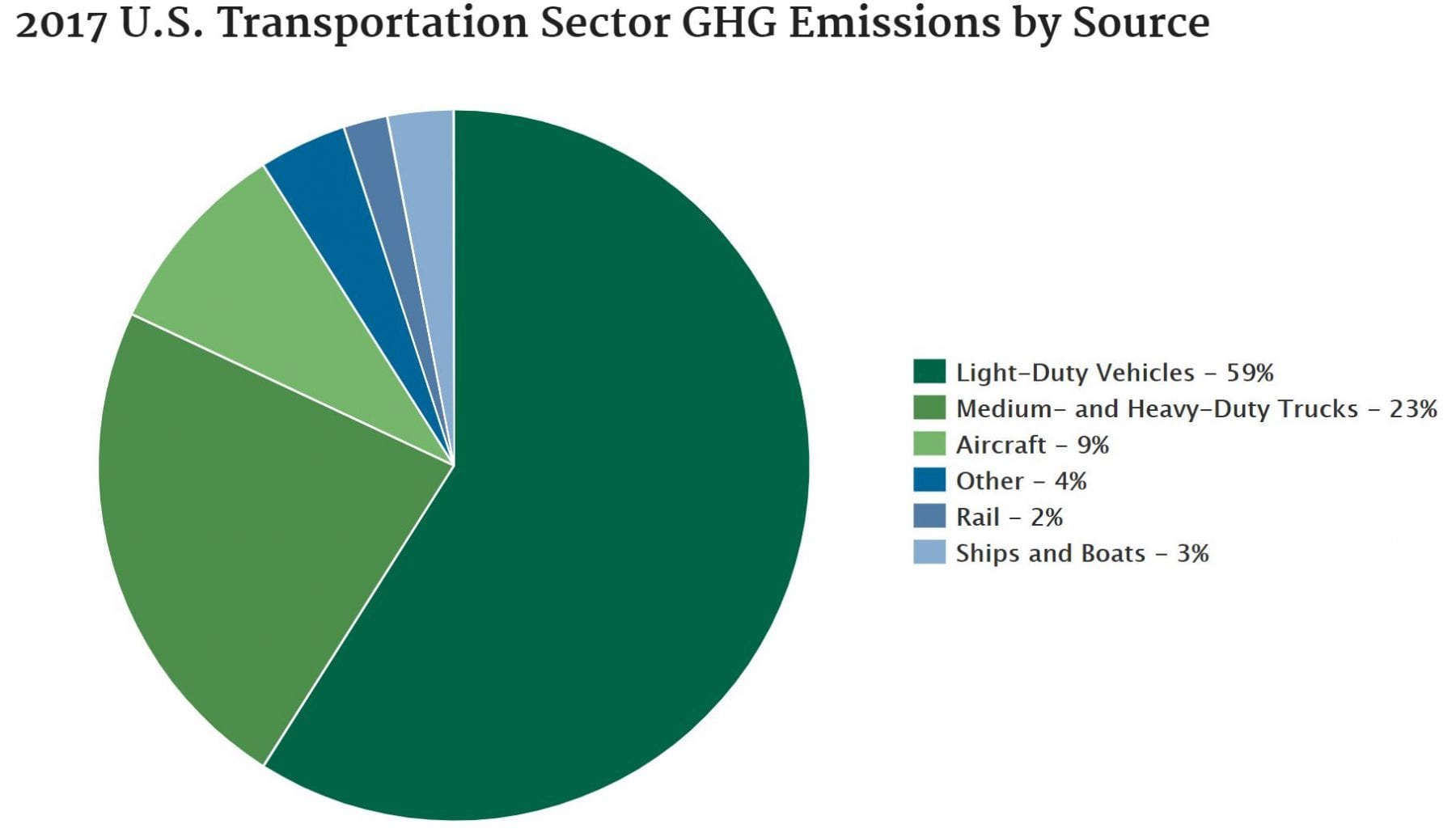
Not only that, but the emissions have been increasing at a much larger rate over the past decade than the emissions of light-duty vehicles.
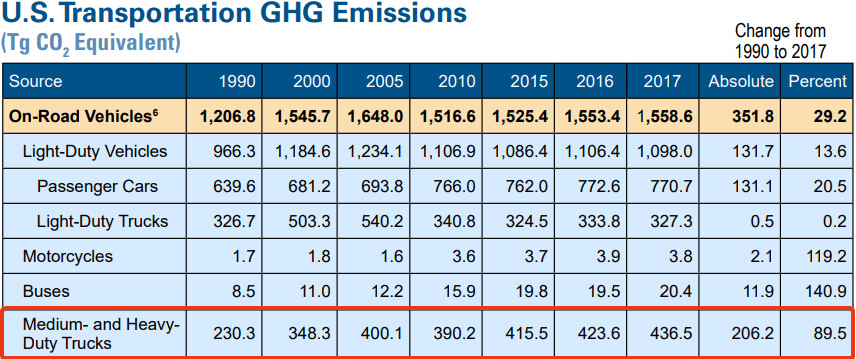
Over the past 27 years, light-duty vehicle emissions have grown by 13.6% while those of medium and heavy-duty trucks (Class 3-8) have jumped 89.5%. Busses have taken the biggest leap, but that’s a different story.
Given how much less commercial trucks there are compared to passenger cars, we will see a significant decrease in emissions in a shorter amount of time by transitioning commercial fleets to alternative fuels.
The question now becomes, what technology will be predominantly used in the commercial sector. The established Tesla brand is unsurprising moving forward with a fully electric Tesla Semi, but the hyped newcomer Nikola Motor brand is providing a hydrogen fuel cell semi as their contender. While there doesn’t necessarily only need to be one or the other technology moving forward, a 50/50 split in market share will be unlikely and the majority will prefer one vision over the other, the only question is, which one will come out on top?
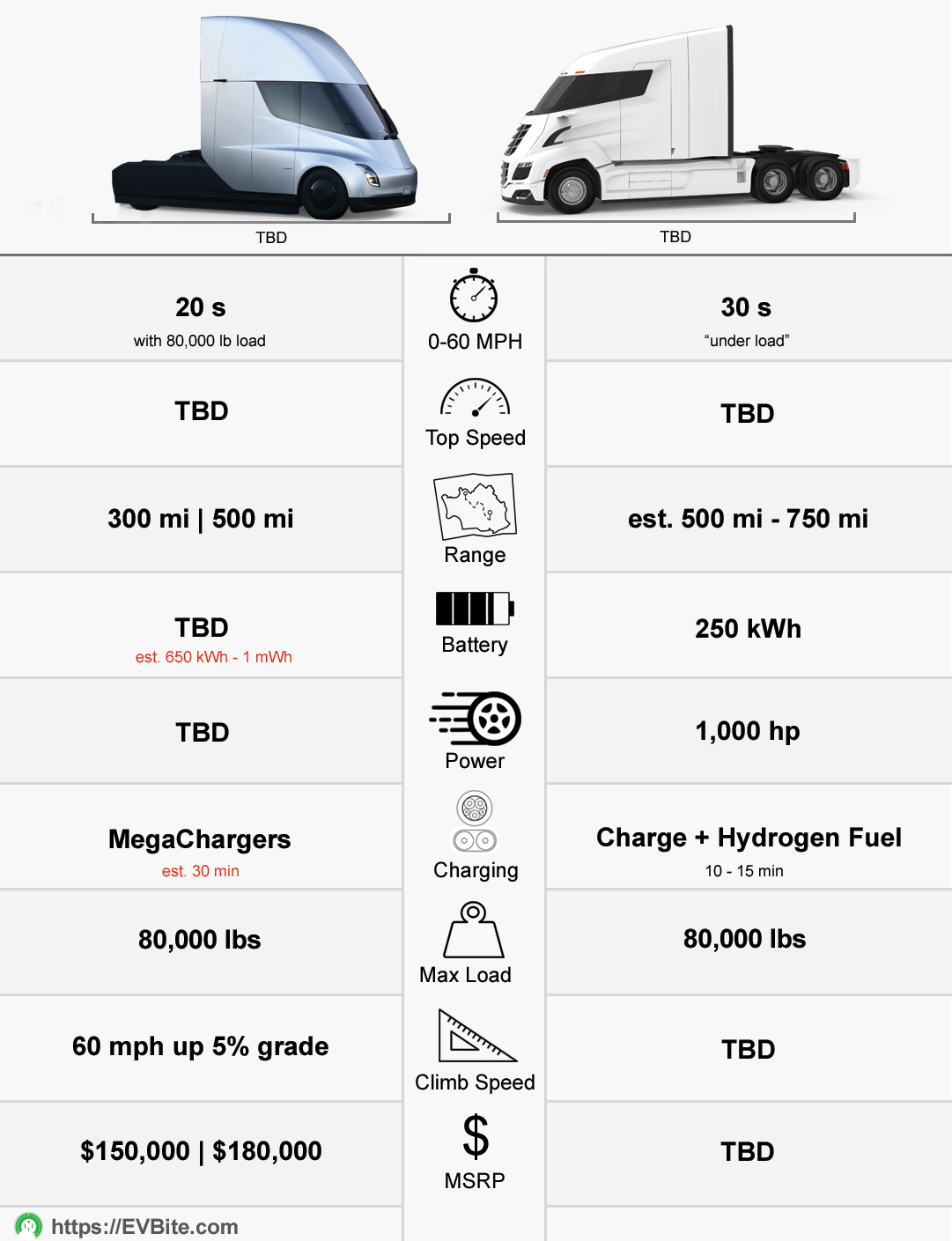
The difference in powertrains is obviously the biggest separation between the two Semi-trucks, so we will tackle that last, first, let’s see how the Tesla Semi and Nikola One stack up against one another.
Design
If you think that the Nikola One and Tesla Semi look awfully similar to one another, you and Nikola’s Founder and CEO Trevor Milton share the same sentiment. Back in May 2018, Nikola started a suit against Tesla alleging that they had infringed on Nikola’s design patents which included a wraparound windshield, cab shape, and utility of the side door. Tesla had denied the allegations and even went so far as to ask the patent office to invalidate Nikola’s side door patent, which was recently denied.
Regardless, the two do look similar, but most semi-trucks today look similar and there are only so few ways you can shape a semi-truck and still retain a peak aerodynamic shape. They both look like semi-trucks, albeit both look much more modern than any semi-truck you see on the road today. The Tesla Semi retains a more clean look and retains the brand’s lack of front grill while the Nikola semi-truck includes a large grill that makes it look more like current semi-trucks. While official dimensions of either have yet to be revealed, the Nikola One does look considerably longer, although I have not seen the two side-by-side so it’s hard to tell from independent pictures.
Looking at the interior we see a further modernization of trucking in both semis. Both the Nikola One and Tesla Semi trucks have forgone the traditional instrument panel and have opted for fully modern touch screens to take care of controlling the vehicle. One big difference between the two is the seating position. In the Nikola One, you have the traditional driver and passenger seating positions with a center console. However, in the Tesla Semi, the driver is in a central seating position, similar to a McLaren F1, and has two touch screens flanking the steering wheel. This does not mean that the Semi only has one seat, there is another seat diagonally to the right of the driver seat.
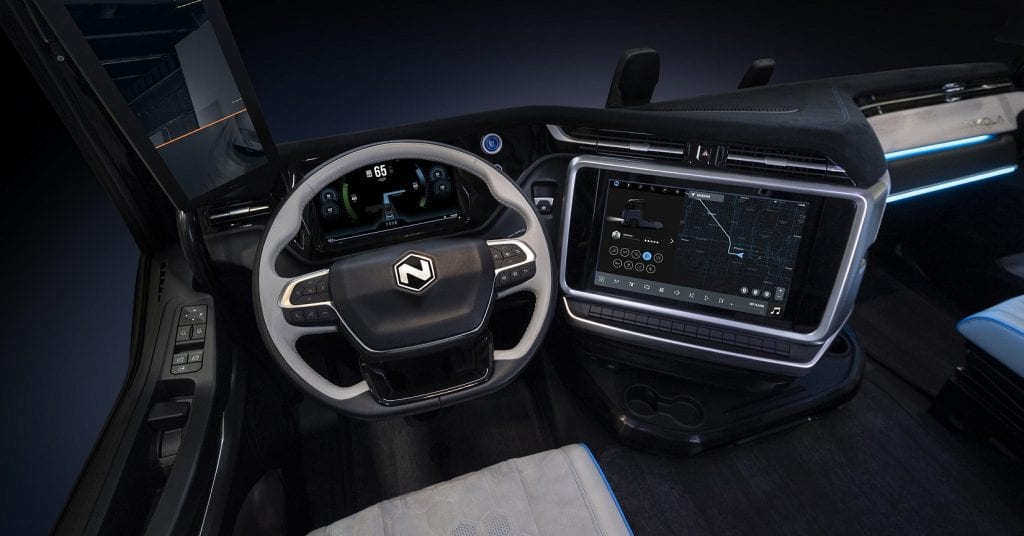

Moving on to sleeping space, Nikola has released concept illustrations of what their sleep cabin would look like, and it looks pretty good and even comes with a little tablet next to the bunk bed that allows you to control different things within the cabin. In the Tesla Semi, it’s a different story. While nothing is official, it seems that the lower range version of the Tesla Semi will not come with a sleeper cabin, while the longer-range version will come with a sleeper compartment, but we have no idea what it will look like. Keep in mind that this information is almost two years old, so who knows at this point. I’m sure that the Semi will come with a sleeper if Tesla intends it to go on long-haul journeys, it’s just a question of whether or not the normal and long-range versions will have different interior designs.
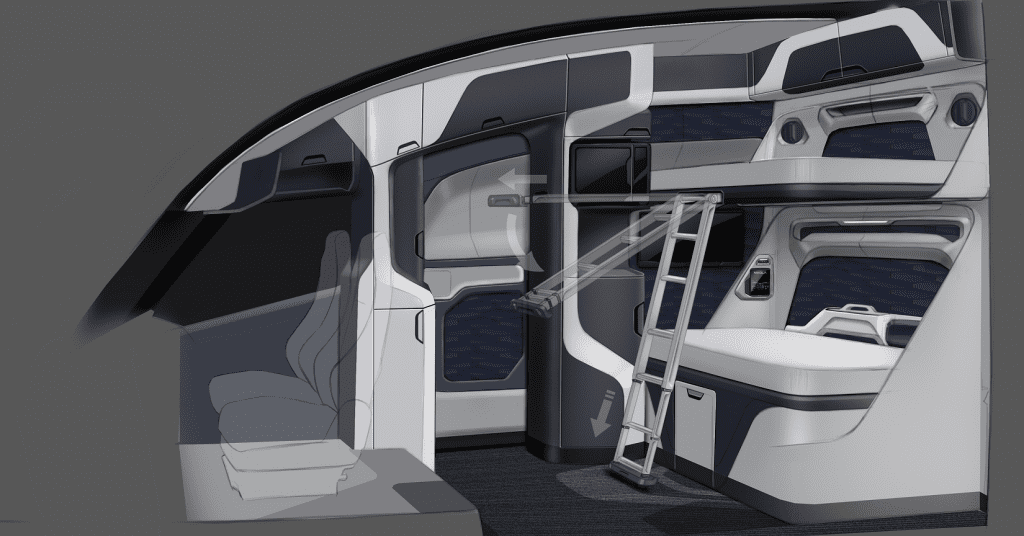
Overall, I think both semi-trucks look pretty decent. I doubt that looks play a huge part when a company is picking out their semi-truck of choice, but it can’t hurt to be the guys with the cool looking trucks.
Performance
Once again, due to the rather rigid structure of semi-truck classes and their requirements, there is little variation in the performance between the two, just like there weren’t any substantial differences in design.
Like with most Class 8 trucks, both the Nikola One and Tesla Semi will be able to tow up to 80,000 lbs. Both the alternative fueled semis will however have a drastic advantage when it comes to 0-60 mph times. Unsurprisingly it’s pretty hard to find 0-60 times for loaded semi-trucks, but Nikola states that it is typically 60 seconds in their comparison. Both the Nikola One and Tesla Semi trunk that number, as Nikola claims that their semi will hit 60 mph in only 30 seconds, while Tesla states that theirs will do it even 10 seconds faster and hit it in only 20.
The biggest differentiator between the Tesla Semi and Nikola One when it comes to performance is the differences in range. Nikola is promising a range of between 500-750 miles, while Tesla will have two different versions of their Semi, one with a range of 300 miles and another with a range 500 miles. So at the moment, Nikola holds an advantage when looking at range numbers alone. However given that neither of these vehicles are officially out, we can expect to see some changes in these numbers as designs and technologies become finalized. For instance, Tesla’s battery day is still on the horizon, so who knows if the Semi will still be disadvantaged in the range department once Tesla talks about their new battery tech. The same applies for Nikola, technology is rapidly evolving, so who knows what the final production numbers will be.
As a comparison, both options still have a long way to go when it comes to matching the longest ranged ICE semis. With an average MPG of 7 and dual 150-gallon tanks, some semis are able to travel over 2000 miles. However truck drivers are regulated on how many hours straight they can drive before taking a break, so it’s almost impossible to drive 2000 miles without a stop regardless, so in the end, a 500 – 1000 mile range might be a more than acceptable goal if fill-ups are quick and easy.
Price
Pricing is another area where we are unable to determine a definite winner at this moment as Nikola has not given the price of their semi-truck. Tesla, on the other hand, has stated that their 300-mile version would cost around $150,000 while their 500-mile version would start at about $180,000.
To put this into perspective, I looked at the pricing of a Freighligher Cascadia, one of the most popular semis on the road right now, and found that they are priced anywhere from $130,000 to around $160,000. So Tesla is within an acceptable price range.
While Nikola has not divulged a price, they are offering a rather comprehensive leasing plan that allows owners to trade in their old semi for a new one every 700,000 miles or 84 months. Not only that, but the lease also includes service and maintenance and hydrogen fuel. Depending on lease pricing, that’s a pretty good deal, and a good way to make the transition away from ICE semis as easy as possible.
Hydrogen Fuel Cell vs. Electric Trucks
Now, the biggest differentiator between the two, and probably most relevant driving force in the decision-making process of which one of these two to get, is the powertrain. The Tesla Semi uses a fully electric system like all their other cars, while the Nikola One uses a hydrogen fuel cell system, similar to something like the Toyota Mirai.
Looking strictly at the makeup of passenger vehicles today, battery electric vehicles clearly outnumber hydrogen cars which are made only by a handful of automakers. Nikola however, feels like there is enough merit in the hydrogen system to warrant using it over battery-electric semis.
Making the case for electric powertrains over fuel cells, electric powertrains hold two major advantages over fuel cell technology right now. The first is that they are simply more energy efficient. Too put it simply, while the process of using hydrogen as a fuel source is still more energy efficient than gasoline, it is still less efficient than a fully electric system by far. Here are two popular infographics floating around that try to illustrate the point as simply as possible.
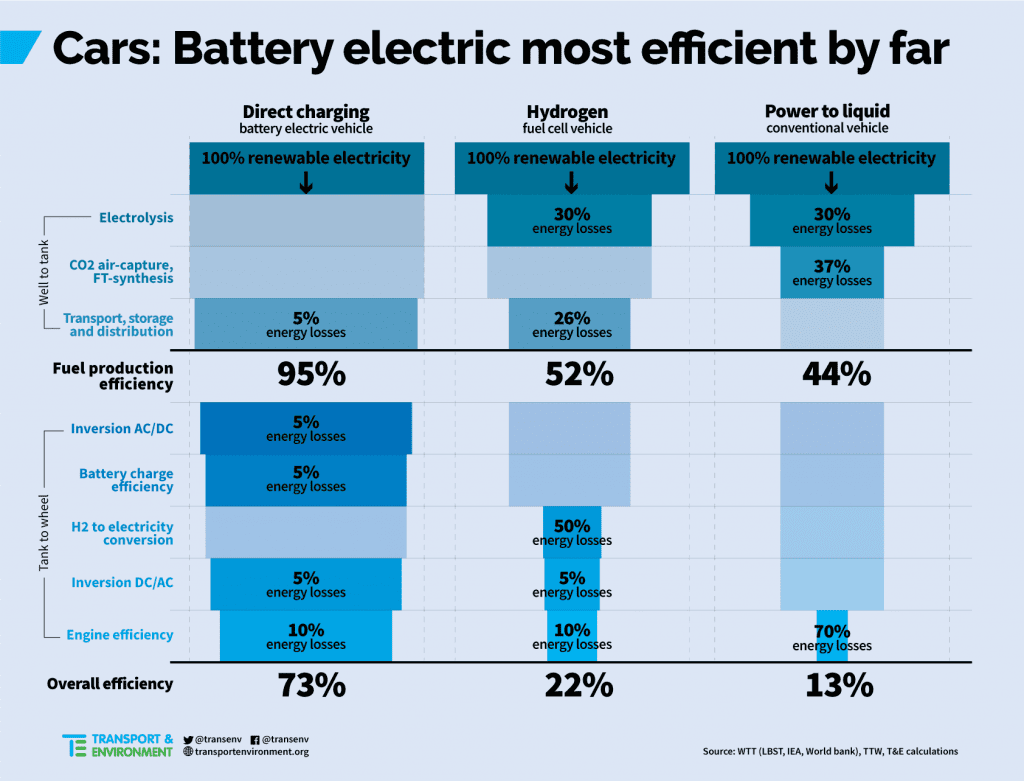

While lower the emissions vehicles are putting out is paramount to the future health of the world, lowering the total amount of energy required to power our vehicles is also a very important objective, especially when the overall efficiency is about three times worse for hydrogen vehicles.
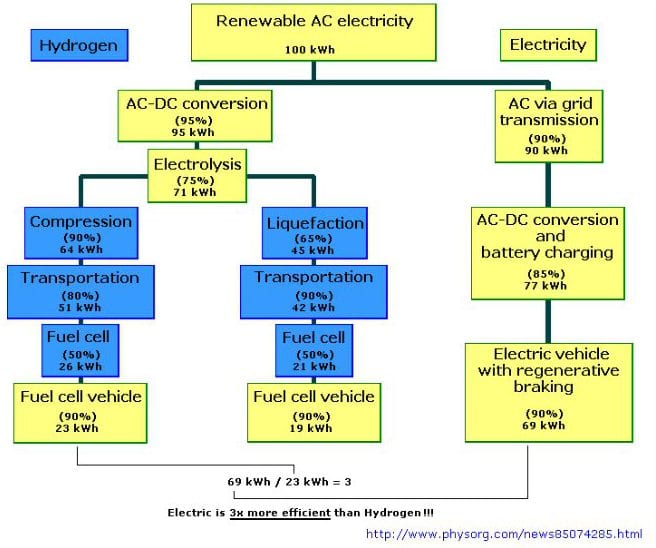
However let’s say the customers of these trucks don’t care too much about the energy difference, especially since hydrogen at the very least looks to be more energy-efficient than gasoline and eliminates carbon emissions. Well, that brings us to the second shortcoming of currently owning a hydrogen vehicle and one that basically cannot be ignored.
The lack of hydrogen refueling stations.
According to the Department of Energy, there are 49 hydrogen fueling stations in North America, with almost all of them within California. Here is the map.

As a refresher, this is what Tesla’s Supercharger Network looks like.

Granted, the Semi will have to rely on its own purpose-built ‘megachargers’ which will deliver much more power than a Supercharger, but it will be much easier for Tesla to place these chargers in already established charging locations than it is for completely new hydrogen stations to pop up.
Now to give Nikola credit, they are addressing the second issue. The company plans to build up 700 hydrogen/electric stations throughout the country by the year 2028. Here is a map of the proposed locations.

It’s pretty good coverage with basically all of the major highways covered. Currently, hydrogen stations are in a catch-22 position, there are no stations because there are basically no cars, and there’s no use in investing in hydrogen cars when there are no hydrogen stations. Nikola will have to parallel what Tesla did with their Supercharger network if they want hydrogen to succeed.
So there must be a benefit to going with hydrogen, Nikola hopefully wouldn’t be purposely making it harder on themselves by going with an inferior product.
At this point in time, the biggest positive that hydrogen has over fully electric is the range. Nikola claims that the Nikola One will have a range of 500-750 miles, while the Tesla Semi will either be 300 miles or 500 miles depending on which you get. This is no doubt a huge plus towards Nikola as basically the first question anyone ever asks when talking about a non-ICE vehicle is, “how far does it go?”.
Secondly, the refueling time will be according to Nikola is only 10-15 minutes. We don’t know how long the charging on the Tesla Semi will be, but given that even the Model 3 can’t get a full charge within 15 minutes, I imagine the Semi with its considerably larger battery will be able to match the refueling speed. It’s debatable how important this advantage is to long-haul journeys as truckers have to take breaks, but for shorter distances, this is definitely a benefit for Nikola.
Lastly, Hydrogen is abundant. It is by far much more abundant than the current materials we use to create batteries. Recently we have regularly seen battery shortages that have cause production of cars such as the Audi e-tron and Jaguar I-Pace to pause while supply could catch up. Maybe this doesn’t matter much for owners of the Semi, but it is possible that a battery shortage could push back orders for the Semi and frustrate customers.
With all this said one will probably ask, “but how long will these advantages hold?”. Battery technology has rapidly been improving, charging times, energy capacities, and materials needed could all change within 5-10 years and overcome all the current shortcomings we currently have. There are no guarantees, however, but if the past 10 years have been any indicator and seeing how much R&D is being funneled into battery tech with more companies starting to make electric cars, it’s hard to not think that we will see significant improvement in the next decade.
Nikola hasn’t put all it’s eggs in one basket, however. While they are definitely pushing for hydrogen, they will have electric versions of their Nikola Two and Nikola Tre, albeit for shorter ranges compared to their hydrogen counterparts.
In fact, not only does Nikola plan for two additional semis but they also are planning a hydrogen/electric truck called the Badger, along with NZT and Reckless off-road vehicles, and even a WAV jetski. One could make the argument that it would make sense to nail one product first before spreading yourself out to seven.
The company certainly has high ambitions and will have a tall order in taking on Tesla who is much more established, as Nikola does not yet even have a factory to call their own. A leaked email from Elon Musk stated that it was time for the Tesla Semi to hit volume production, so if the Tesla Semi can come out significantly earlier than the Nikola One, then it would certainly make the decision easier for those companies who want to distance themselves from fossil fuels as quickly as possible.
What do you guys think of the upcoming battle? Which semi do you think will be more popular? Is there a different alternative-fueled semi-truck that you feel is even better than either of these two? Let us know down in the comments below.
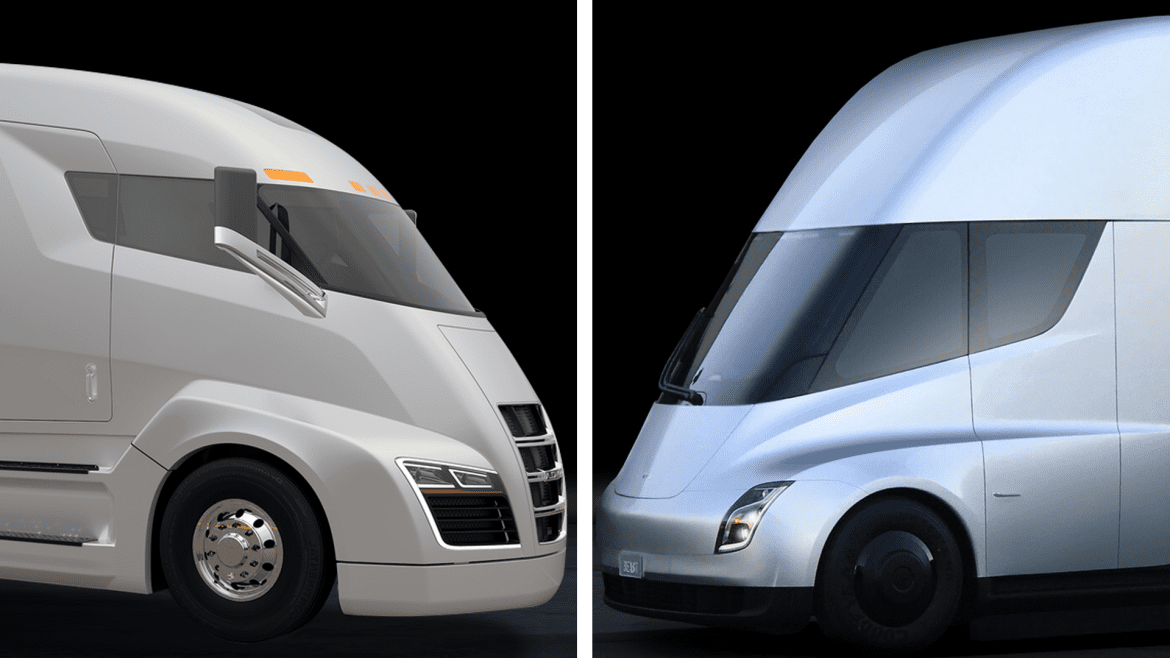
2 comments
This was a good article. However, regarding the re-charging time, it overestimated the Tesla battery truck efficiency, it should be more than a hour for a full charging. FCEL should be 10-15 min, which was reasonable for hydrogen filling. Another thing, this article neglect the real temperature conditions, in winter seasons, battery car or trucks cannot perform their full charging capacity, however, FCEL can still perform well , which was certicified by the technicians in very old winter in Northeastern China.
Great article. Very informative and sheds light into a potential wonderful future for consumers above all.